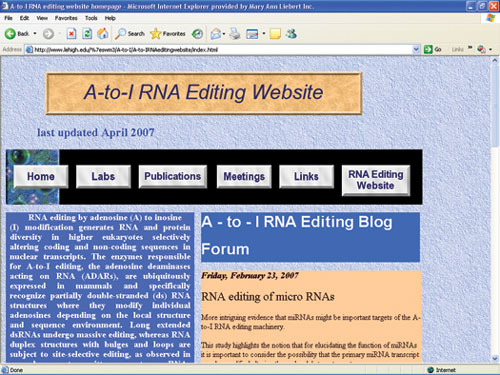July 1, 2007 (Vol. 27, No. 13)
URL:
http://www.lehigh.edu/%7eswm3/A-to-IRNAeditingwebsite/index.html
Rating:
Strong Points: Extensive reference collection, links
Weak Points: Database needed
Summary:
Remember the “good old days” when the central dogma ruled and nucleic acids were largely looked at as giant unalterable cellular blueprints? The more we learn about DNA and RNA, the more this doctrine looks like a quaint convention of a simpler time. Indeed, molecular biology today recognizes not only that RNA information can flow to DNA (reverse transcription), and that eukaryotic genes are usually in pieces in the DNA and must be spliced to make mature (and useful) RNA, but also that RNA itself can be altered in several nonsplicing mechanisms collectively referred to as editing. RNA editing is a phenomenon whose occurrence is now recognized to take place in most eukaryotic organisms. It varies from insertion of bases at specific places in mRNAs (mostly in simple eukaryotes) to chemical modification of bases in most other eukaryotes. The latter process most commonly involves conversion of adenosine to inosine by action of adenosine deaminase. At the A-to-I RNA Editing website, you’ll find everything you need to know about this latter process and gain insights into its significance for the cells that perform it.



